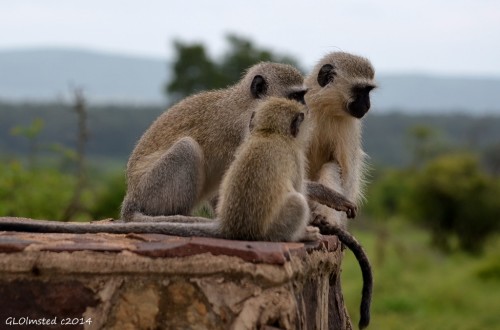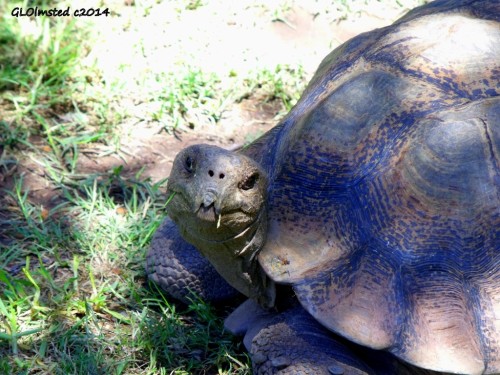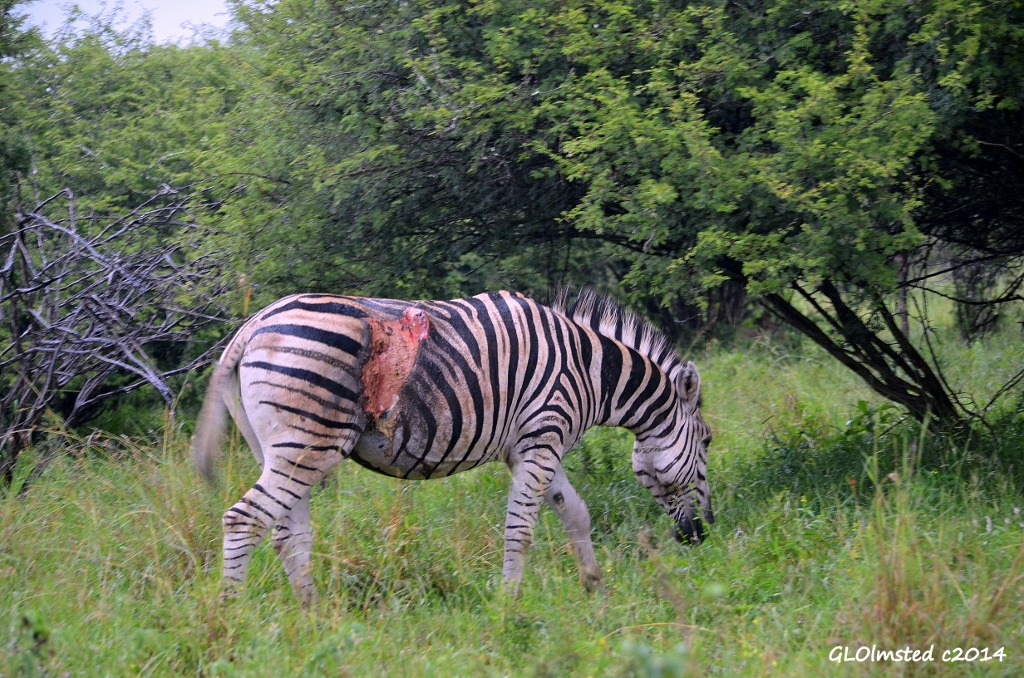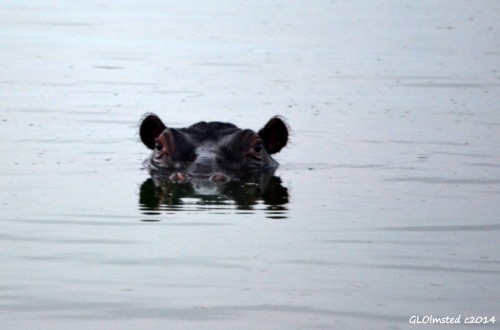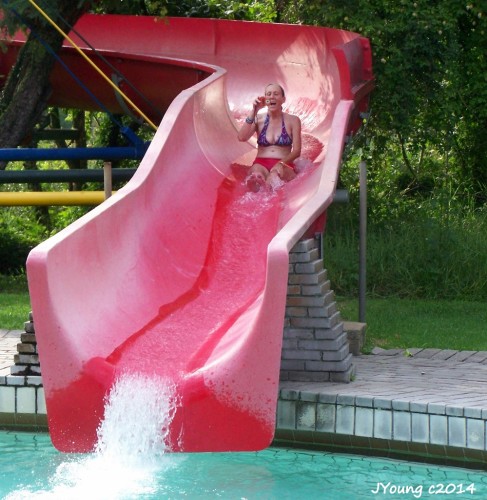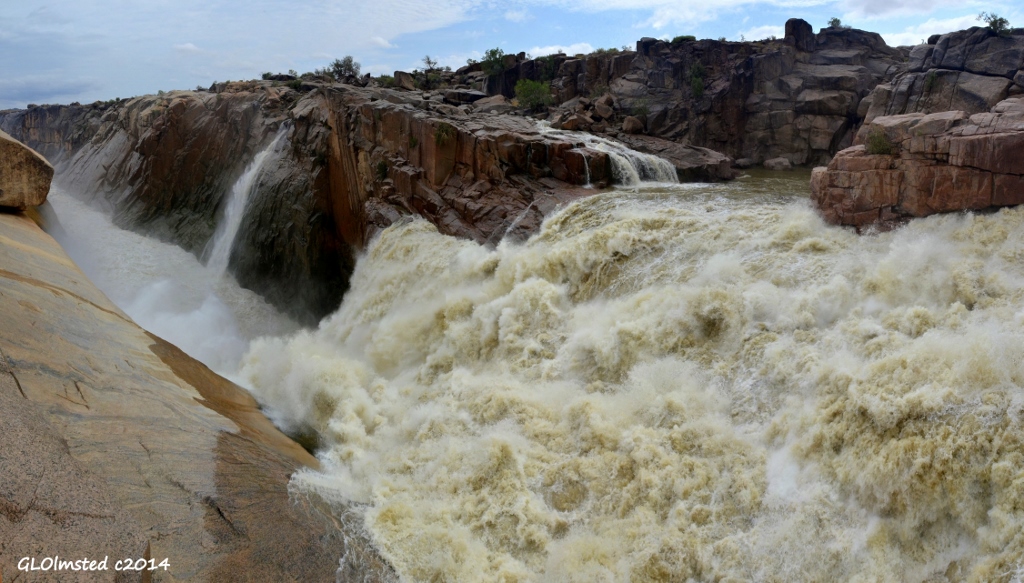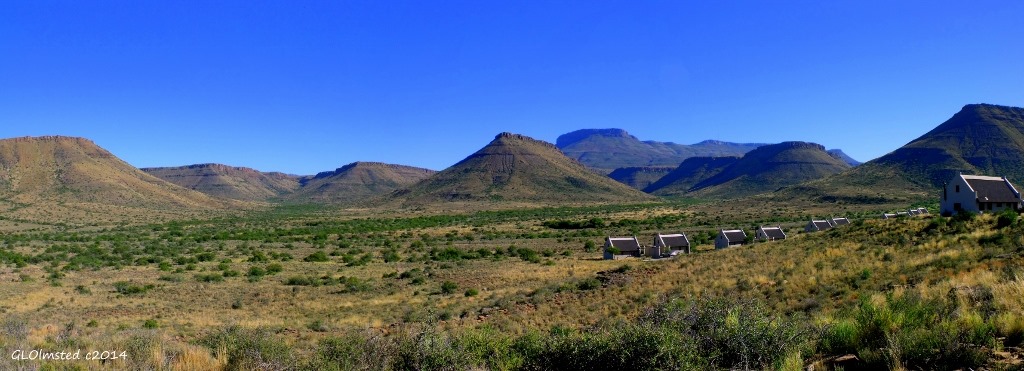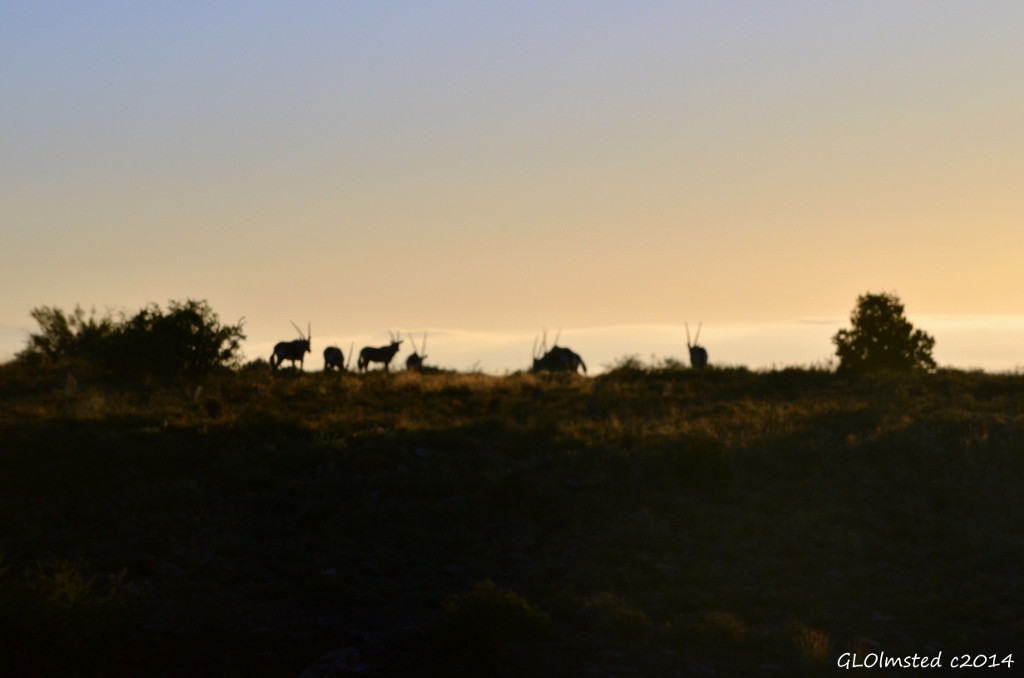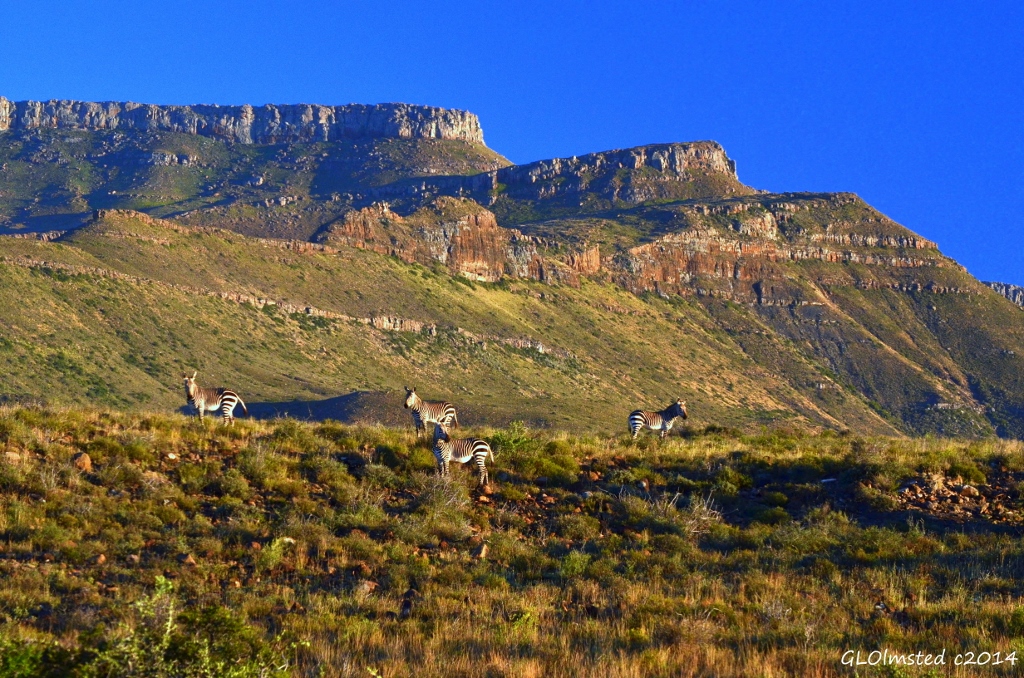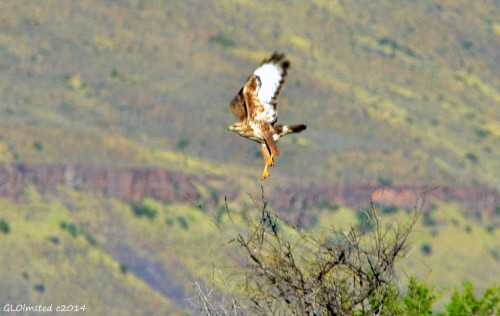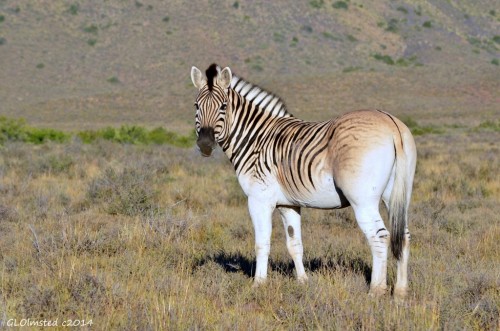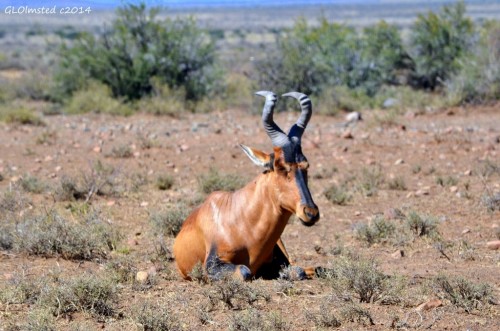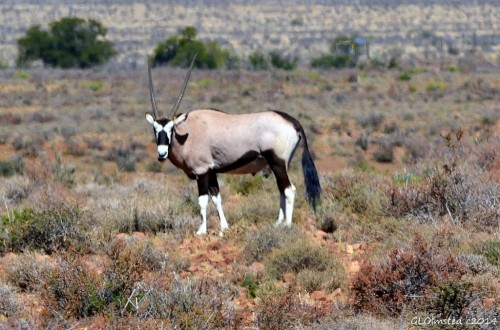Seems as all dogs are curious including this pair of young wild dogs seen at Kruger National Park South Africa. They stopped to sniff at every little thing on the road from leaf to dung.
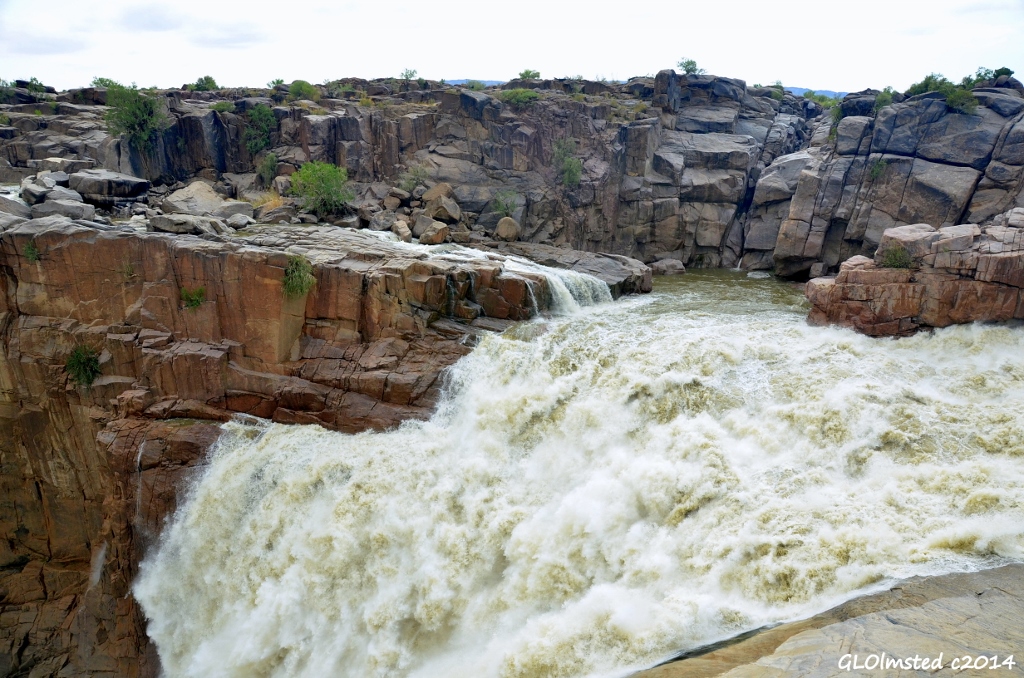 Yes, I’ll be celebrating 60 years of life today at Augrabies Falls in South Africa, National Park #10.
Yes, I’ll be celebrating 60 years of life today at Augrabies Falls in South Africa, National Park #10.
Blogging since 2008 has brought many rewards, including writing and sharing my stories and meeting many people online who also have dreams. Then in 2010 I took my first step off my own continent and visited South Africa. A magical land that captured my spirit. I returned in 2013 and am back again in 2014.
My family thinks I’m crazy. I come from a family of monkeys.
I’ve dreamed of traveling all my life, drooling over the images in National Geographic as a child. Upon high school graduation I dreamed of traveling across the USA in a horse covered wagon taking photos and sharing my story in National Geographic. We all have a dream.
But instead life got in the way. I got a job, got married, raised step-children, went to college, got divorced, became a National Park Ranger. And all that time I continued to travel, and dream.
I celebrated 50 years in Oregon with friends from Oregon Caves National Monument. We had a big bonfire at a friend’s home and I’d asked people to bring something they wanted to get rid of to throw in the fire. I wrote on a piece of paper that I wanted to be less impatient and for the next three months I waited for EVERYTHING. So I learned patience and then decided I didn’t like waiting so I gave that up. I dreamed of another 50 years ahead of me.
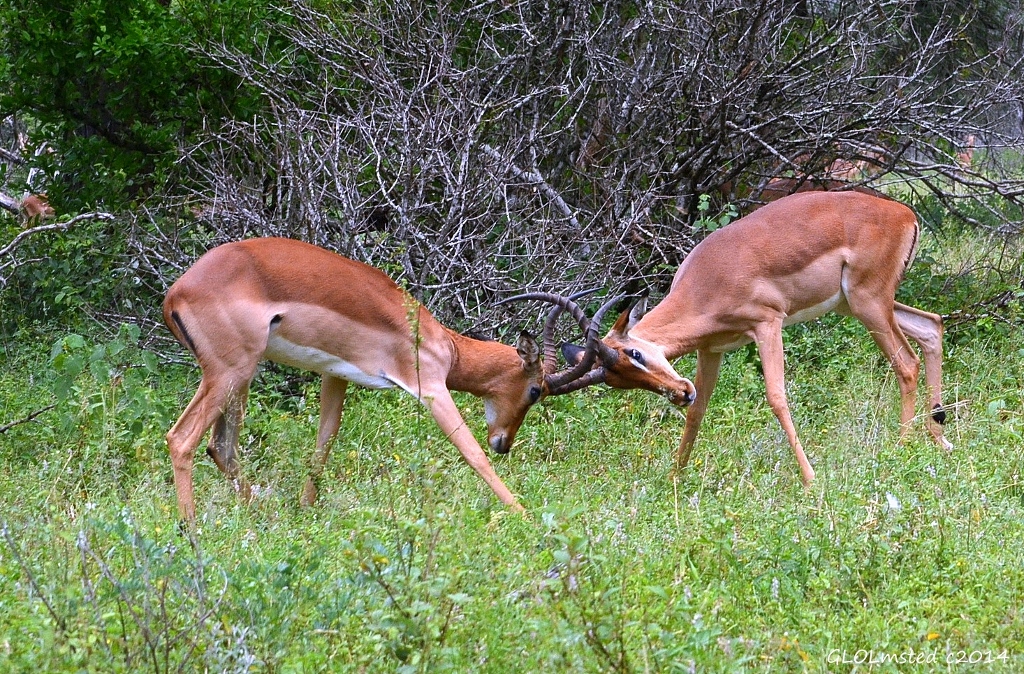 I’ve butted heads more than once.
I’ve butted heads more than once.
I celebrated 40 years in Mexico with my ex-husband camping along the Caribbean just south of Tulum. I spent the day in a terrible self-imposed funk inside the camper with wind blowing the beach sand sideways. I knew the marriage was over and hated myself for staying in it. I dreamed of being single and by the next year I was happily divorced.
Sometimes I’m just a slow learner.
I celebrated 30 years in a hospital watching my step-daughter get her stomach pumped from taking all the pills in our medicine cabinet in an attempt at suicide, or maybe it was just a cry for help. Being a teenager isn’t always easy. And neither is being a parent. I dreamed of a better life for her, and me.
I’ve gotten into a few scrapes along the way.
I celebrated 20 years in southern Illinois with the current live-in boyfriend. In fact I quit a job to have my birthday off, because it is MY day after all. I’d asked two weeks in advance for the day off from a job at a cafeteria where I decorated and cut pies and cakes. Because my birthday fell on Easter that year I was told they would be very busy and I had to work. So I gave them two weeks notice. On my last day at the close of business I asked a fellow employee to send the manager into the back prep area for me to say goodbye. I was waiting with a full, giant sized pastry bag full of whipped cream and squirted him all over his three piece suit as a going away gift. I filled my dream of getting back at him for not giving me the day off.
I like to be sneaky sometimes.
I celebrated 10 years in the suburbs of Chicago where I grew up. In fact it was the last birthday party my Mom organized for me as I got in trouble the following summer. We lived at the end of a dead end road next to a swamp where I was told not to play but of course did. I came home one day covered in tar from a bucket that had been left behind by a nearby construction crew and after Mom scrubbed me down with turpentine in the tub I was informed, “No more birthday parties for you!” I dreamed of a party until a friend threw me a surprise party for my Sweet 16th.
I’m not beyond getting into trouble while having fun.
I wonder what 70 years of life will bring? I dream of more travel and meeting more wonderful people from around the world. And maybe more of you bloggers as well.
(After rain Monday night and waking up in a lake with my tent floating we are now dry and warm in a Chalet for the next two nights at Augrabies Falls. Joan is taking me to dinner here for my 60th birthday. A wonderful way to celebrate!)
Karoo National Park makes #6 on the parks list for this visit to South Africa. Located in the Great Karoo, a rather desolate and unforgiving landscape of semi-desert that covers 1/4 of South Africa, is dominated by the Nuweveld Mountains. ‘Karoo’ is derived from a Khoekhoe word meaning ‘dry’.
 The Karoo offers high elevation grasslands with some rainfall and low arid dwarf shrublands. This diversity is partially because of a geologic story over 100s of millions of years old.
The Karoo offers high elevation grasslands with some rainfall and low arid dwarf shrublands. This diversity is partially because of a geologic story over 100s of millions of years old.
Geology and Fossils
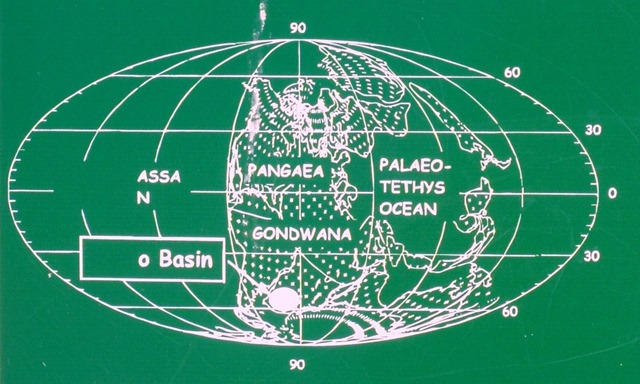 About 255 million years ago during the late Permian period when all the continents were clustered together forming Pangaea present day continents south of the equator like Africa, South America, Australia, Antarctica, India and the Middle East were called Gondwana. The Karoo Basin was located in a landlocked region isolated from the ocean by a major mountain range and sediments were deposited by huge rivers, lakes and sandy deserts. Almost 100 million years later, when Gondwana started to pull apart, the sediments were intruded by hot dolerite magma and covered by a thick layer of basalt lava.
About 255 million years ago during the late Permian period when all the continents were clustered together forming Pangaea present day continents south of the equator like Africa, South America, Australia, Antarctica, India and the Middle East were called Gondwana. The Karoo Basin was located in a landlocked region isolated from the ocean by a major mountain range and sediments were deposited by huge rivers, lakes and sandy deserts. Almost 100 million years later, when Gondwana started to pull apart, the sediments were intruded by hot dolerite magma and covered by a thick layer of basalt lava.
 In the time since, surface rocks have been stripped away by erosion leaving the Great Escarpment to the north and exposing 250 million year old fossils in the Karoo Basin of the dominant herbivores and carnivores called Therapsids, early mammal-like reptiles that predate dinosaurs.
In the time since, surface rocks have been stripped away by erosion leaving the Great Escarpment to the north and exposing 250 million year old fossils in the Karoo Basin of the dominant herbivores and carnivores called Therapsids, early mammal-like reptiles that predate dinosaurs.
![]()
 An accessible quarter mile (400 meter) fossil trail in Karoo National Park displays examples of these early vertebrates like the herbivore Bradysaurus with long rows of flattened hand-shaped teeth designed for cropping riverine vegetation. Large quantities of foliage would be sliced and swallowed without chewing then digested by gut microbes which probably released immense volumes of waste gasses. In other words, a noisy and smelly eater.
An accessible quarter mile (400 meter) fossil trail in Karoo National Park displays examples of these early vertebrates like the herbivore Bradysaurus with long rows of flattened hand-shaped teeth designed for cropping riverine vegetation. Large quantities of foliage would be sliced and swallowed without chewing then digested by gut microbes which probably released immense volumes of waste gasses. In other words, a noisy and smelly eater.
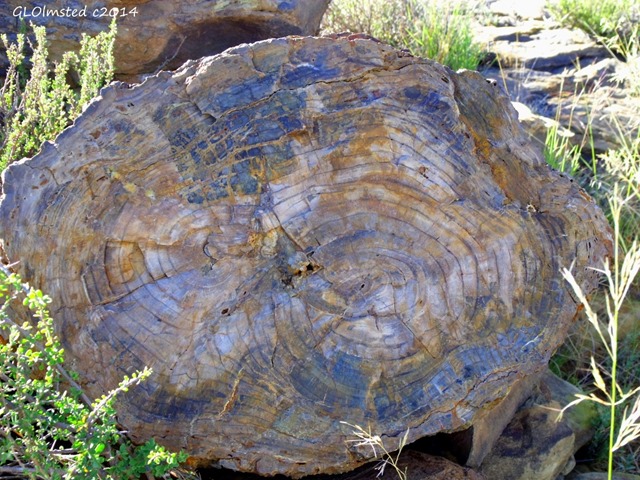 Petrified primitive gymnosperm
Petrified primitive gymnosperm
Fossil finds from the Karoo are renowned for therapsids that show a subtle transition between reptiles and mammals although not true mammals. Almost all of the fauna of the Karoo was wiped out at the end of the Permian about 251 million years ago when severe global warming caused intense long lasting drought.
Diverse ecosystems
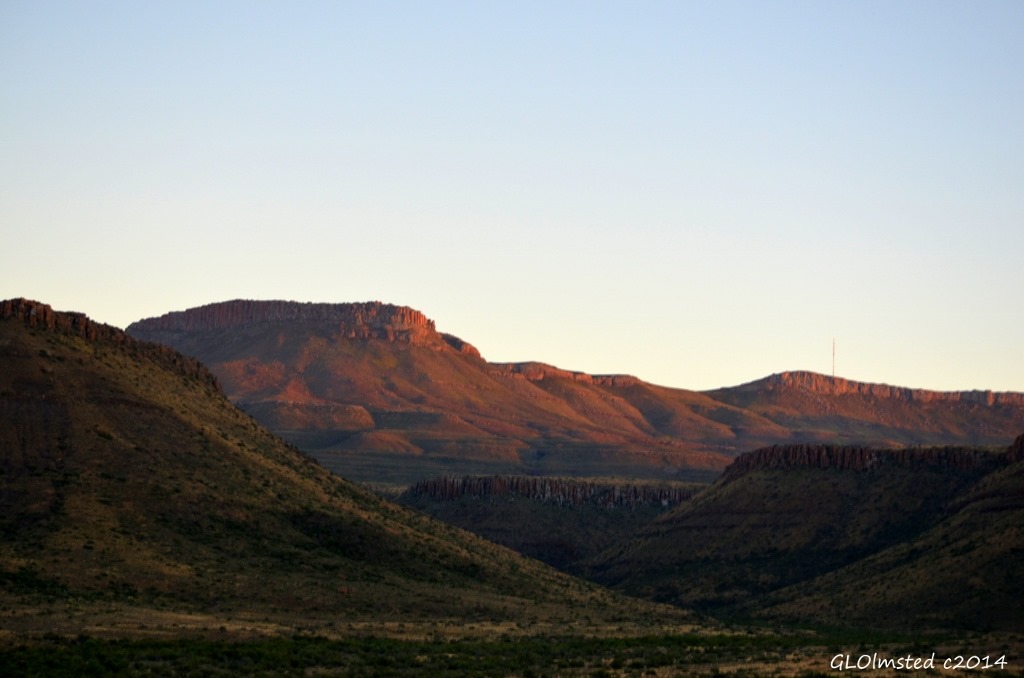 Knowing the geologic story puts the current landscape into perspective. For example at the highest elevation with relatively high rainfall, course grain size and good soil drainage the vegetation is dominated by grasslands. While the slopes below the escarpment of fine soil with smaller grains like clay retains water thus not allowing plants to absorb the moisture so succulents are seen here having adapted to the dryness. These compacted clay surfaces allow water to drain into the floodplains below where precipitation is low, soil is deep and shrublands and grasses occur.
Knowing the geologic story puts the current landscape into perspective. For example at the highest elevation with relatively high rainfall, course grain size and good soil drainage the vegetation is dominated by grasslands. While the slopes below the escarpment of fine soil with smaller grains like clay retains water thus not allowing plants to absorb the moisture so succulents are seen here having adapted to the dryness. These compacted clay surfaces allow water to drain into the floodplains below where precipitation is low, soil is deep and shrublands and grasses occur.
Wildlife
Then, understanding the habitat needs of the wildlife helps to know where certain species are likely to be seen. Grazers, those that eat grasses, are seen both on the top and in the valley including gemsbok, red hartebeest, ostrich and both Burchell’s and Mountain zebras. Whereas browsers which eat from bushes and low trees like the kudu and black rhino (the later we did not see) are only seen in the lower elevations. There are 63 mammal species found in the park.
Seed and insect eating birds are mainly found in the grasslands, birds of prey almost everywhere and the park reports the best birding found around the lush riparian area near the campground.
 We saw ostrich everywhere yet they are also seen outside the park where they are raised for meat, feathers and hide. The lean red meat is quite delicious and the feathers, from the light brown female only, are died in every imaginable color for feather dusters.
We saw ostrich everywhere yet they are also seen outside the park where they are raised for meat, feathers and hide. The lean red meat is quite delicious and the feathers, from the light brown female only, are died in every imaginable color for feather dusters.
The Karoo National Park has a wide variety of endemic wildlife. Many species have been relocated to their former ranges – such as brown hyena, lion and Cape mountain zebra. Over 20 breeding pairs of black eagle find sanctuary within the park. There is also a wide diversity of succulent plants and small reptiles.
History
A land long known and used by early humans during the stone age as far back as 1.2 million years ago when people developed stone points and blades used rock shelters and embellished themselves with shells and ostrich egg buttons and beads eventually producing clay pots and trading for metals. Survival of the nomadic San people depended on the gathering of plants and hunting of game until about 1400 years ago when the Khoekhoen herders came into the Karoo. Because of the dryness even early European farmers lived a nomadic life until underground water sources were tapped with windpumps at the end of the 19th century.
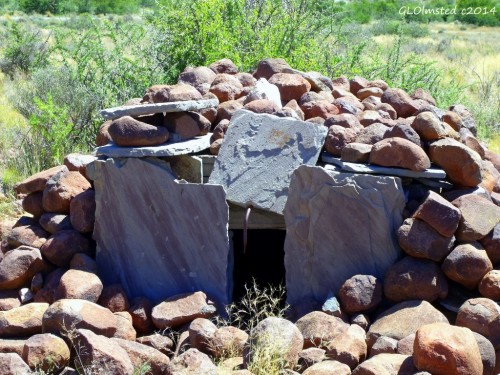 So farming has a long tradition in the Karoo, particularly sheep, and predation by leopard, jackal and hyena caused the loss of livestock. To counteract this, traps were built and some are still preserved, but no longer used, in the park. The hyena trap is a stone structure built to lure in animals with bait secured to a pin at the rear of the trap and a rope connecting the bait to another pin on a trapdoor which when tugged would trap the animal inside. A small narrow opening located above the bait enabled the farmer to see inside and insert a rifle or spear to kill the trapped animal.
So farming has a long tradition in the Karoo, particularly sheep, and predation by leopard, jackal and hyena caused the loss of livestock. To counteract this, traps were built and some are still preserved, but no longer used, in the park. The hyena trap is a stone structure built to lure in animals with bait secured to a pin at the rear of the trap and a rope connecting the bait to another pin on a trapdoor which when tugged would trap the animal inside. A small narrow opening located above the bait enabled the farmer to see inside and insert a rifle or spear to kill the trapped animal.
 Because the Karoo is such a uniquely diverse environment a decision was made to create this national park before farming practices completely destroyed it. In the late 1950s a campaign started to conserve an area near Beaufort West but the park wasn’t proclaimed until 1979 with opposition from local farmers who feared the reserve would become a protected breeding ground for predators that would prey upon their sheep. Although the number of predators has increased so has the prey so the loss of livestock has not been a problem.
Because the Karoo is such a uniquely diverse environment a decision was made to create this national park before farming practices completely destroyed it. In the late 1950s a campaign started to conserve an area near Beaufort West but the park wasn’t proclaimed until 1979 with opposition from local farmers who feared the reserve would become a protected breeding ground for predators that would prey upon their sheep. Although the number of predators has increased so has the prey so the loss of livestock has not been a problem.
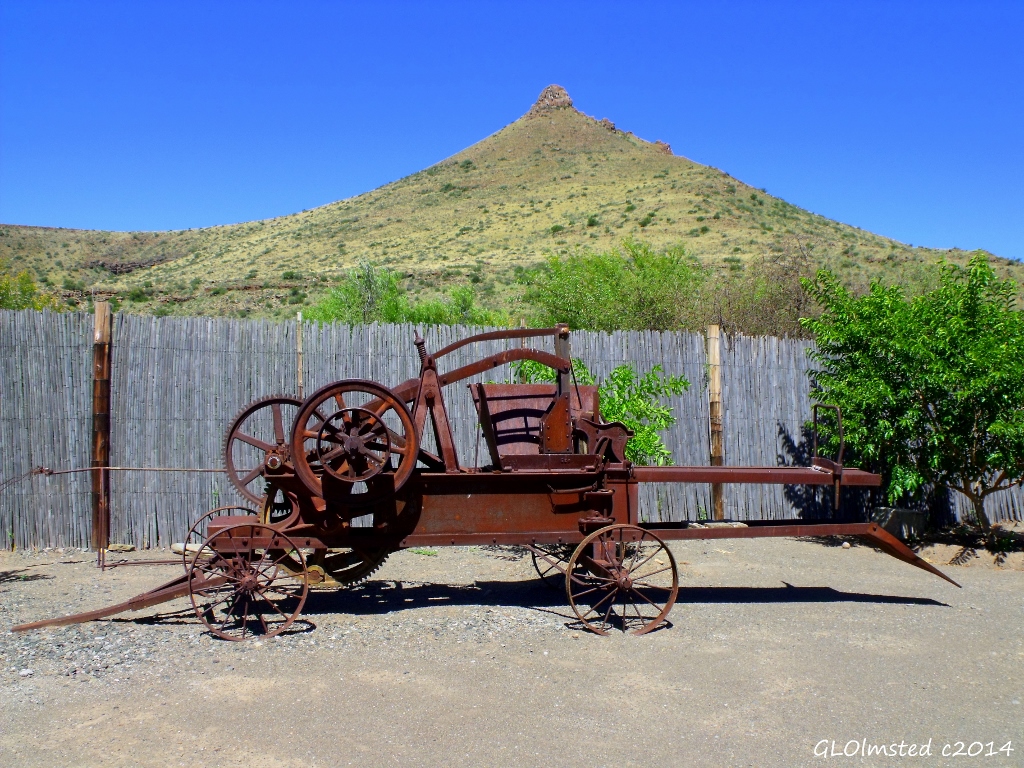 The Interpretive Center displays some of the old farm implements as well as the geologic history, fossil story and examples of stone age tools. Plus a delightful garden to walk through.
The Interpretive Center displays some of the old farm implements as well as the geologic history, fossil story and examples of stone age tools. Plus a delightful garden to walk through.
Activities
As previously mentioned, there is the Fossil Walk with displays and interpretive signs which I thoroughly enjoyed. There is also the .5 mile (820 meter) long Bossie Trail which highlights the desert flora but it was too hot for us during mid-day and in the mornings and late afternoons we chose to self game drive instead.
Because we aren’t driving a 4×4 our game drives were limited to the paved 7.5 mile (12.1 km) Lammerjiesleegte and rough gravel 27.6 mile (44.5 km) Potlekkertjie loops. However there are many miles of 4×4 only roads as well.
Guided hikes and game drives are also available. And a bird hide overlooking a small wetland which we didn’t stop at for a lack of birds.
Facilities
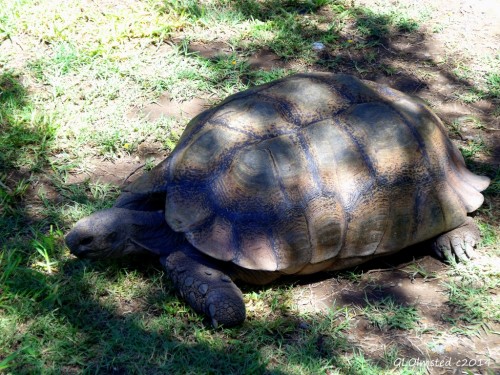 The Bulkraal picnic spot has a swimming pool, ablution and braai facilities. A restaurant open for breakfast and dinner. A shop with curios and basic commodities. 37 Dutch style cottages with one or two bedrooms. 24 campsites with power, communal ablutions (shower and baths), kitchen with stove plates, dish washing facilities, freezer and refrigerator, and laundry room with washer and dryer. Take care as there is a huge resident Leopard tortoise in camp so check under your vehicle before you drive. Swimming pool for overnight guests. Full conference equipment and catering service. And the town of Beaufort West is 7.4 miles (12 km) away from the rest camp, with shops, a golf course, pharmacy, fuel station, hospital, bowling green, and the Chris Barnard Museum.
The Bulkraal picnic spot has a swimming pool, ablution and braai facilities. A restaurant open for breakfast and dinner. A shop with curios and basic commodities. 37 Dutch style cottages with one or two bedrooms. 24 campsites with power, communal ablutions (shower and baths), kitchen with stove plates, dish washing facilities, freezer and refrigerator, and laundry room with washer and dryer. Take care as there is a huge resident Leopard tortoise in camp so check under your vehicle before you drive. Swimming pool for overnight guests. Full conference equipment and catering service. And the town of Beaufort West is 7.4 miles (12 km) away from the rest camp, with shops, a golf course, pharmacy, fuel station, hospital, bowling green, and the Chris Barnard Museum.
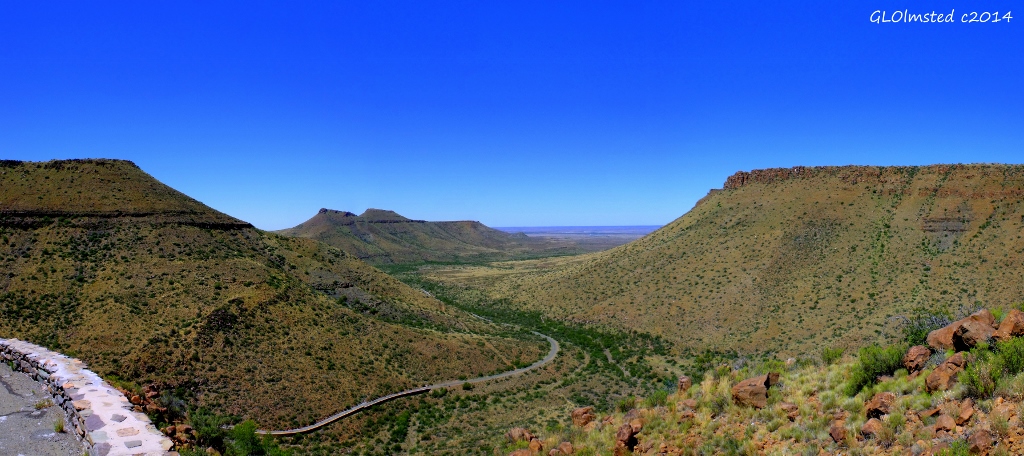 Unless you have a 4×4 I’d say a couple day’s stay is enough. We camped two nights. The rough road over the mountains didn’t provide much game viewing but has awesome views.
Unless you have a 4×4 I’d say a couple day’s stay is enough. We camped two nights. The rough road over the mountains didn’t provide much game viewing but has awesome views.
Animal sightings
Steenbok, Red Hartebeest, Ostrich, Tortoise, Black Eagle, Black-backed Jackal, Springbok, Mountain Zebra, Burchell’s Zebra, Eland, Gemsbok, Kudu, Grey Rhebok


